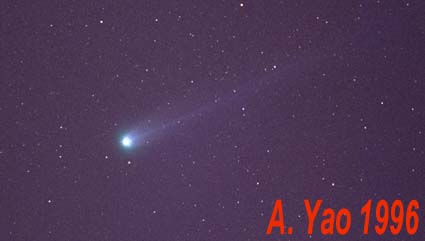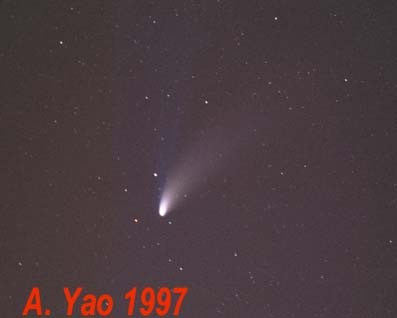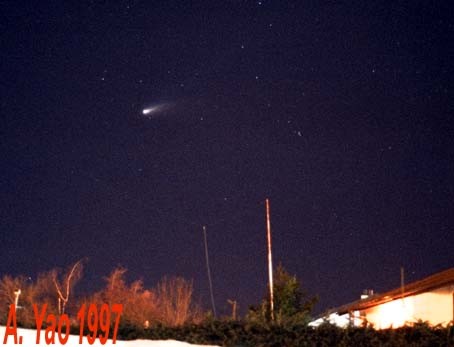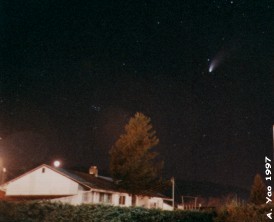last updated 22-Feb-2009
by Anthony Yao
in BC Canada
I started to sky watching whilst I was a kid, begining with the identification of the North Star, the Summer Triangle, eventually I tried to explore same dynamic experiences - the comets. They are not on my wish list.
The two comets in 1996 and 1997 were brighter than expected, they could
be seen relatively high over the horizon 2-3 hours after the sunset !
I started to watch comets since 1973, I watched the Comet Kohutek in Hong Kong,
it was an exceptional experience to discover a faint image in a clear sky
with a 7x35 binocular.
In 1986 I have developed enough knowledge to prepare for the return of
the Comet Halley, tracking it for about a month before it sank too low in
the horizon. In the same year, I watched the comet form the window of a 737-300 at an altitude of 30,000 feet.
In 1996, with the advancement of high speed T-grain colour films,
an aggressive attempt to picture the comet with amateur equipment, a series
of exposures of 2-20 secs with 4 secs increment were conducted. The exposures
were kept relatively short to avoid the blurring of the images.
The proximity of the comets of 1996 and 1997 to Earth and the relatively
clear skies in Kitimat, Canada also contributed to the success of end
pictures.
A 2002 movie "A walk to Remember" has mentioned about the Comet Hyakutake, the actress Mandy Moore and actor Shane West viewed the comet through a home built telescope, in the reality - the comet was visible by the naked eye for a month after her perihelion, no telescope was ever needed. The discoverer, Mr. Yuji Hyakutake passed away in Japan in 2002, just 3 months after the movie took her debut in USA.
In 1996 with the clear sky in Kitimat, Canada\i was able to view and photographed the Comet Hyukutake with ameture film and instruments. The proximity of the comet to Earth and the clear skies redered a fairly acceptable image
In 1997 the Comet Hale-Bopp was viewed by naked eye and photographed showig the faint blue tail with ameture film and instruments.
Thanks to the perfection of the
T-Grain
technology, not even
push-processing was needed.
Exposure was kept to within 15 seconds or less, the effects of
recipical failu€ in modern films was minimal.

|
Comet Hyakutake as seen on April 5th 1996 from Kitimat, Canada
Tech Info -
Kodak Gold 400, 100 mm lens, at f/2.8, 10 secs. c-41 process, no push processing.
|

|
Comet Hale-Blop as seen on May 8th 1997 from Kitimat, Canada
Tech Info -
Kodak Gold 400, 100 mm lens, at f/2.8, 6 secs C-41 process, no push processing.
|

|
Comet Hyakutake as seen on April 9th 1996 from Kitimat, Canada
Tech Info -
Kodak Gold 400, 28 mm lens, at f/5.6, 10 secs C-41 process no push processing
|

|
Comet Hale-Bopp as seen on May 8th 1997 from Kitimat, Canada
Tech Info -
Kodak Gold 400, 28 mm lens, at f/4, 12 secs C-41 processing, no push processing.
|



